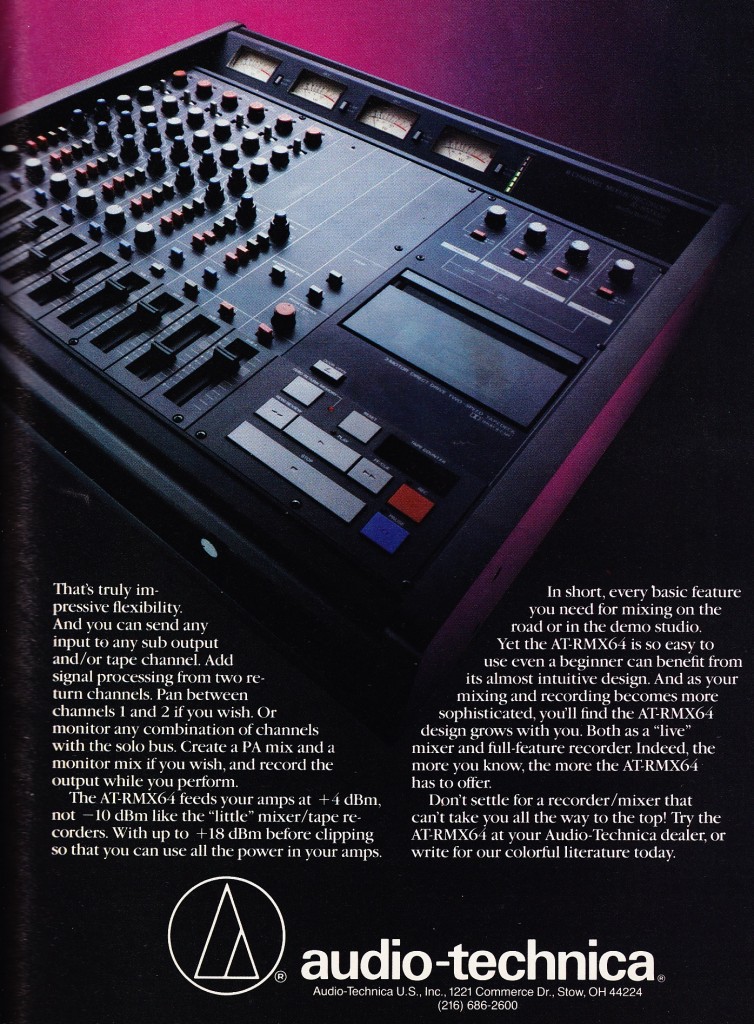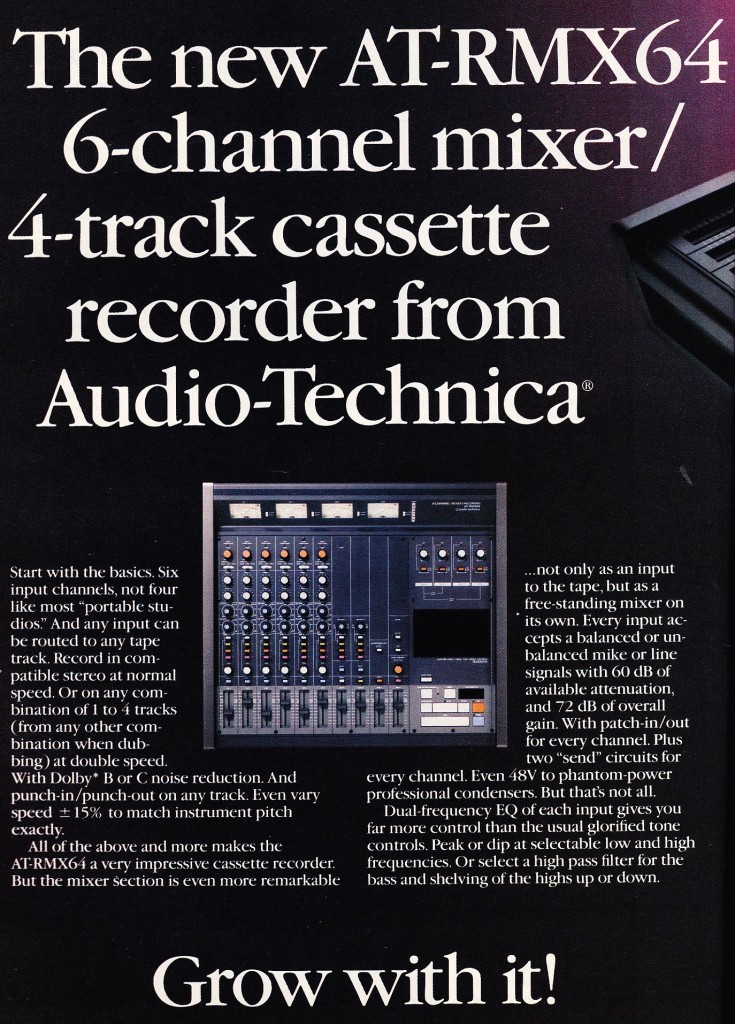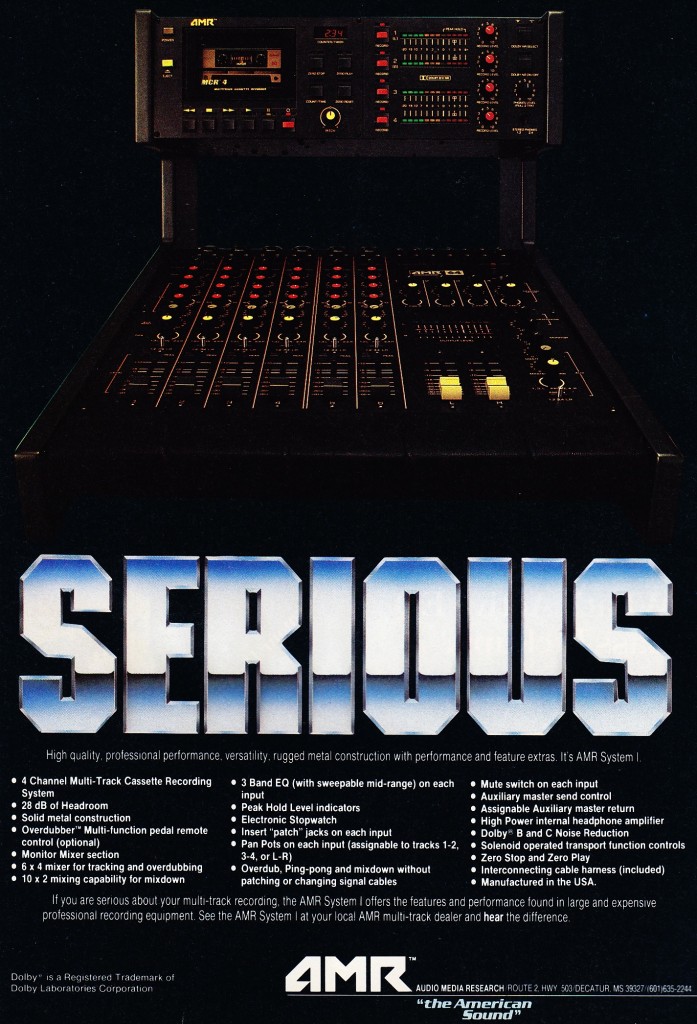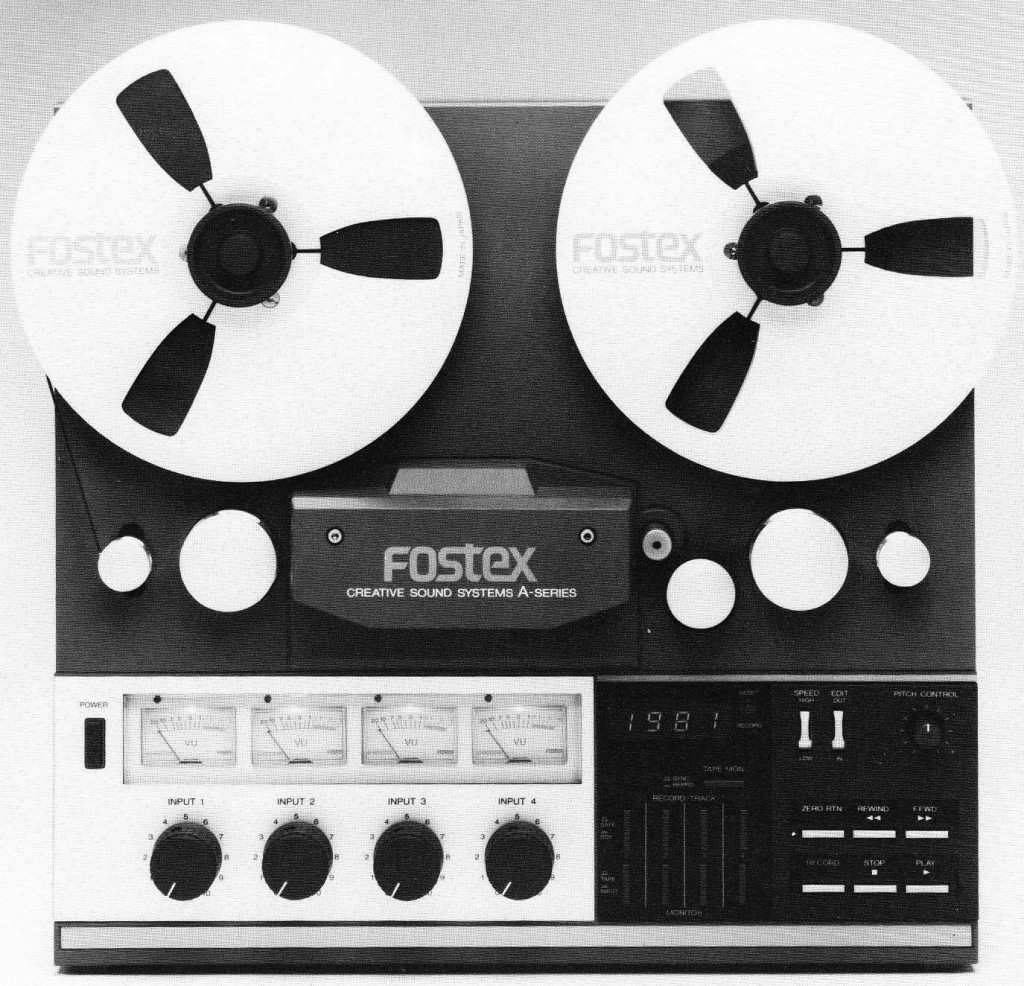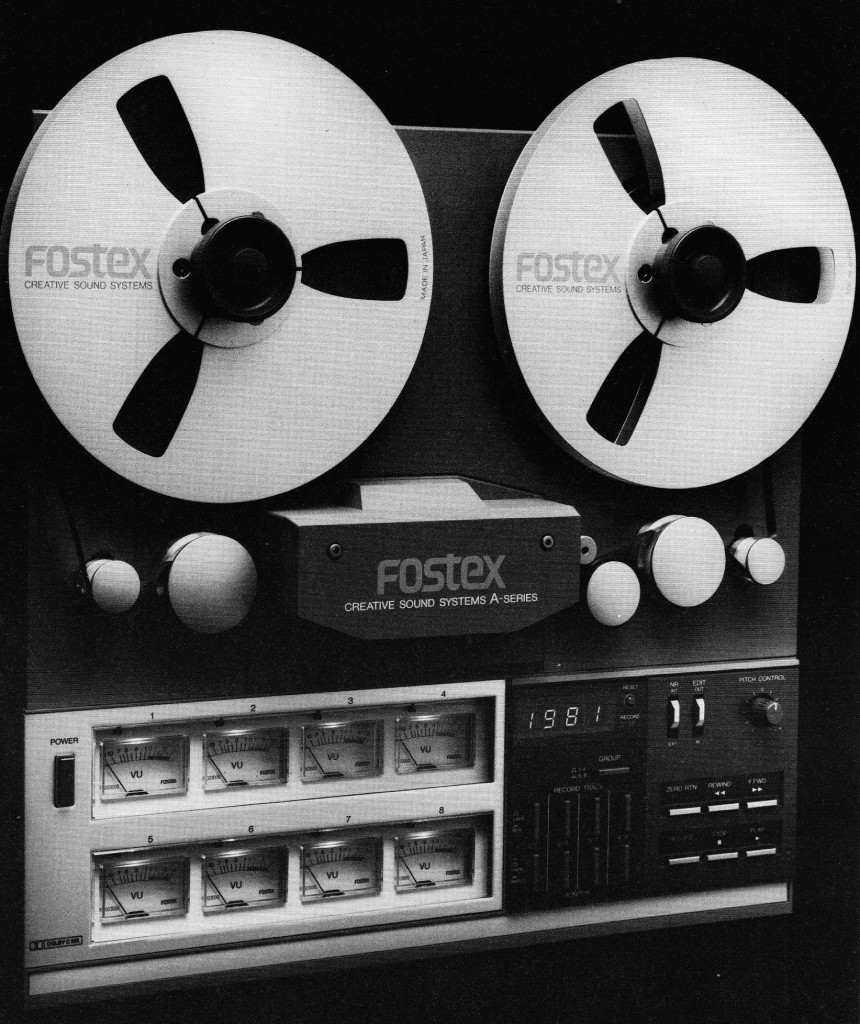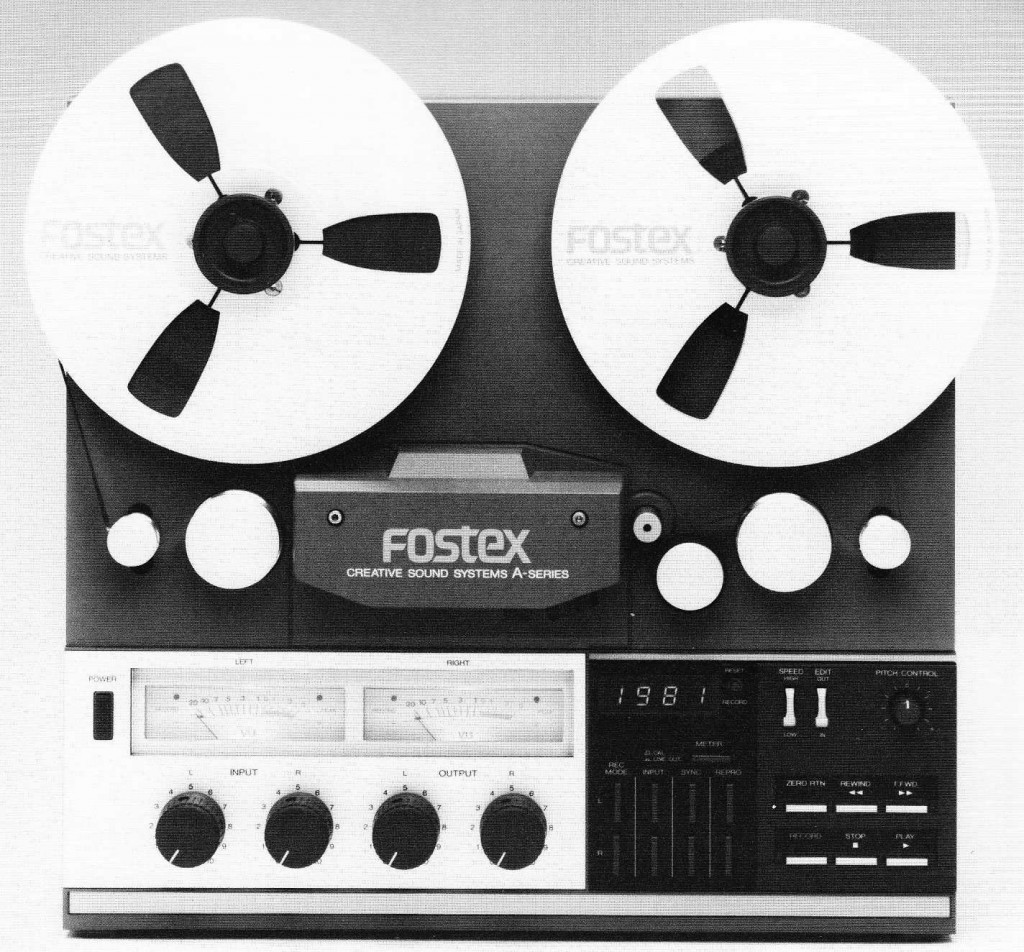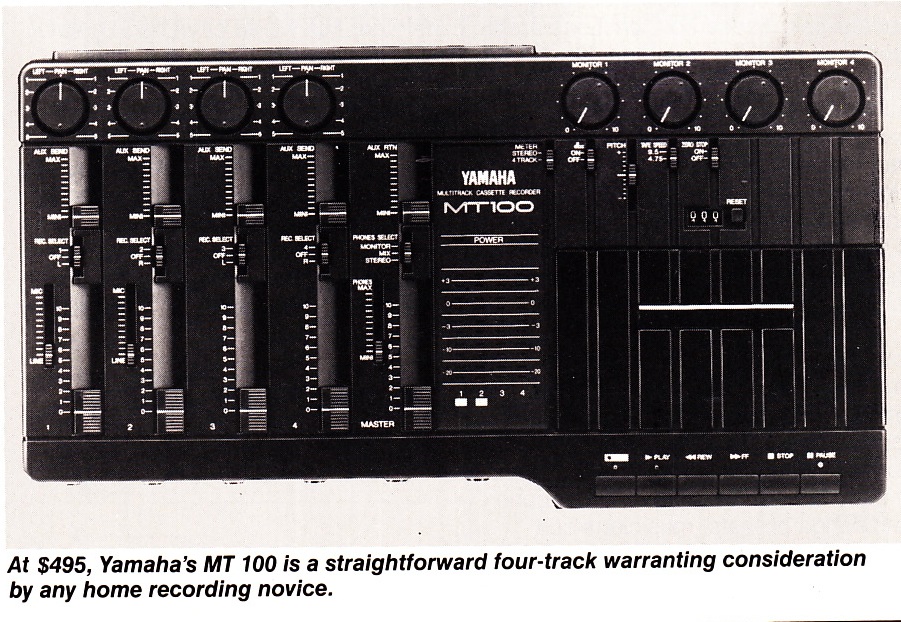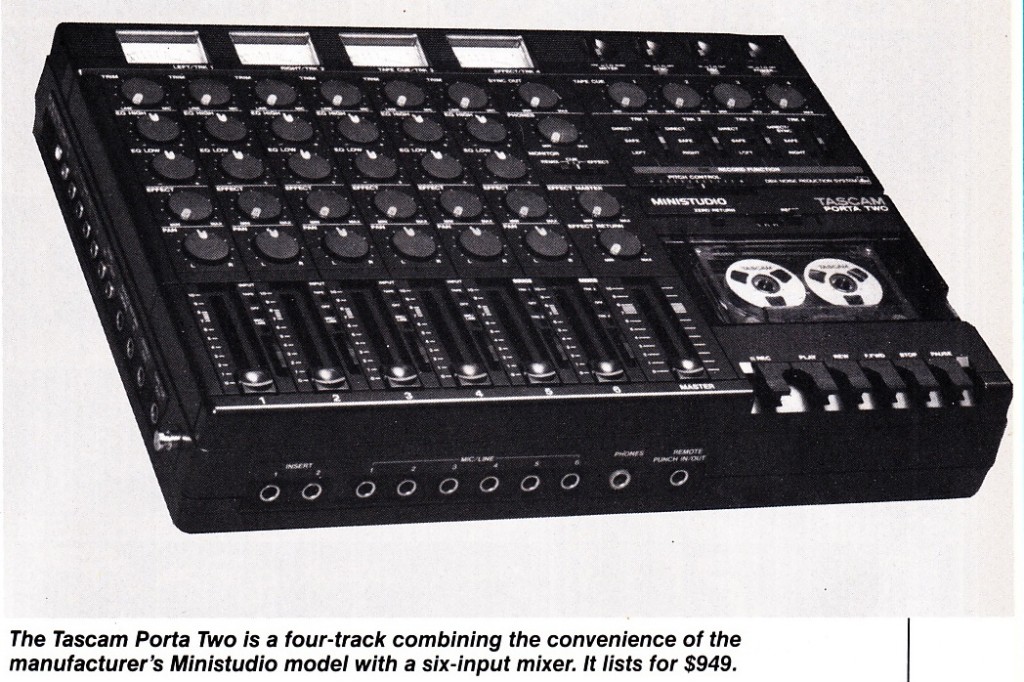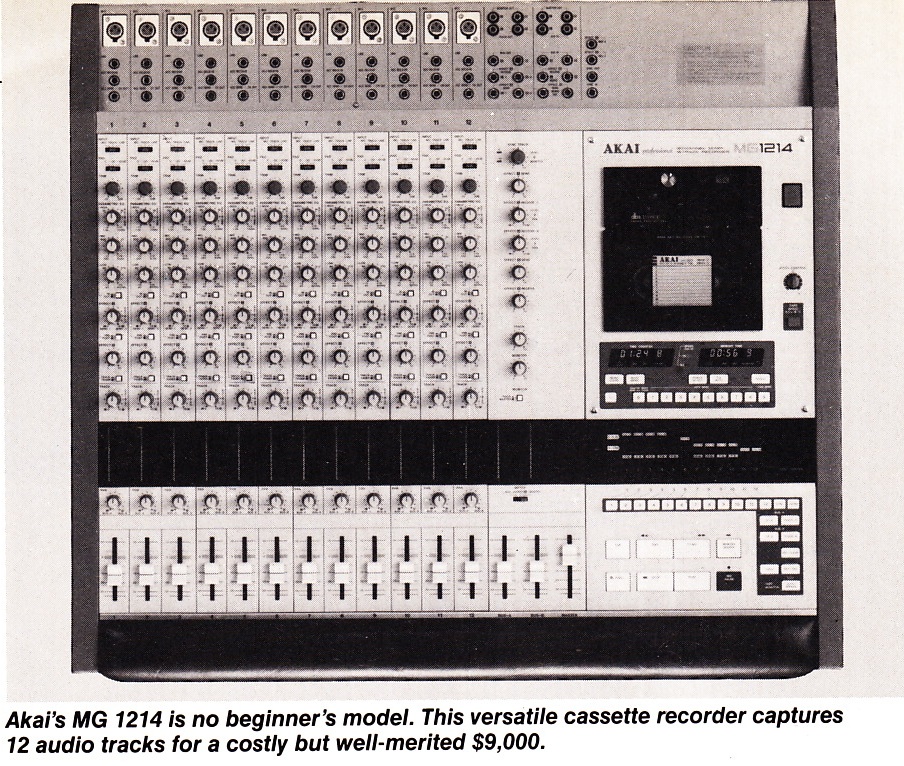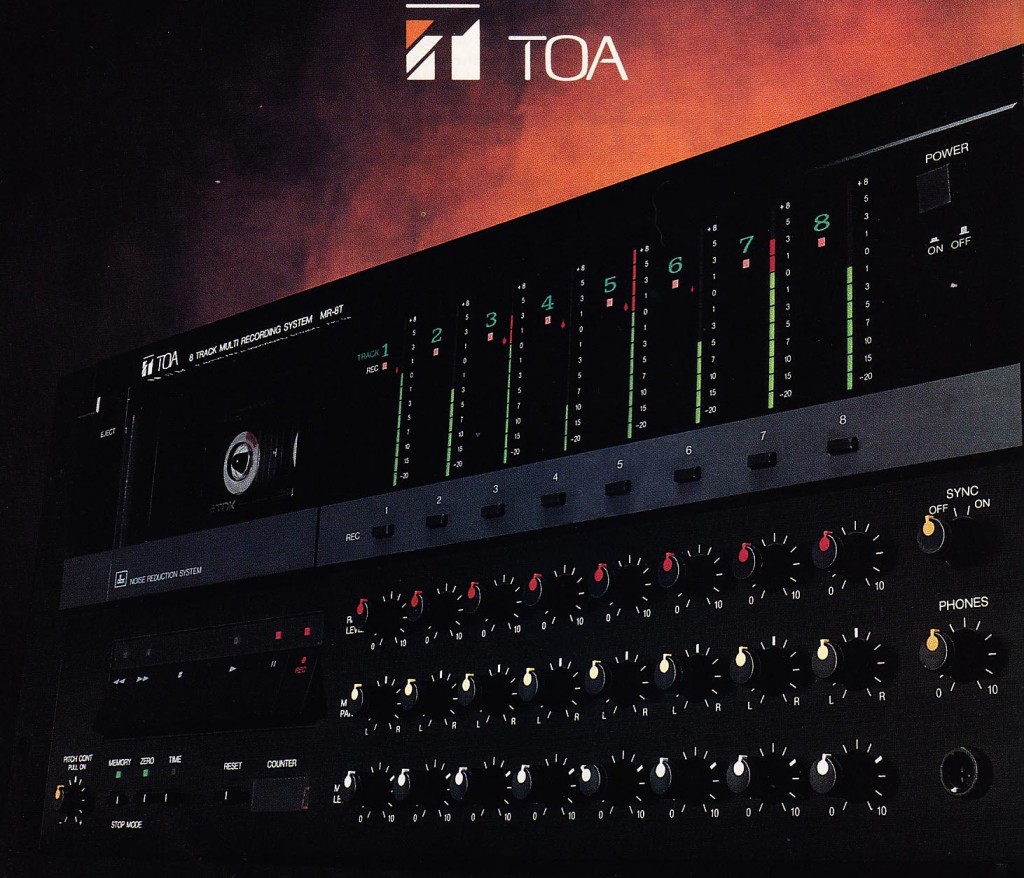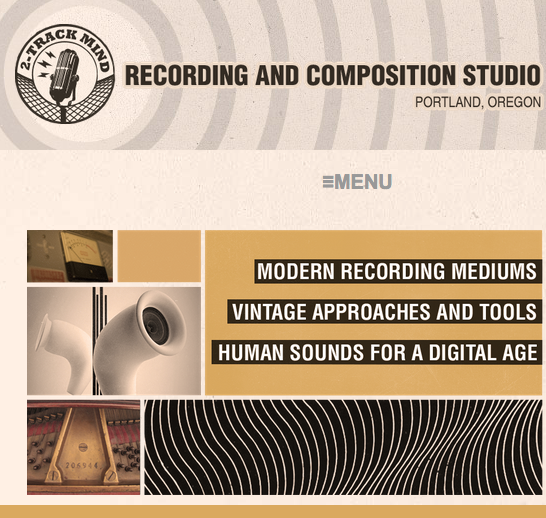 Hey y’all: the cassette-tape experimentation series continues with a new piece created on the amazing Tascam 134 machine. I’ve written about it as a guest-spot on Seth Lorinczi’s Two Track Mind blog. Click this link to hear the track and check it out,,,
Hey y’all: the cassette-tape experimentation series continues with a new piece created on the amazing Tascam 134 machine. I’ve written about it as a guest-spot on Seth Lorinczi’s Two Track Mind blog. Click this link to hear the track and check it out,,,
Tag: the 4-track
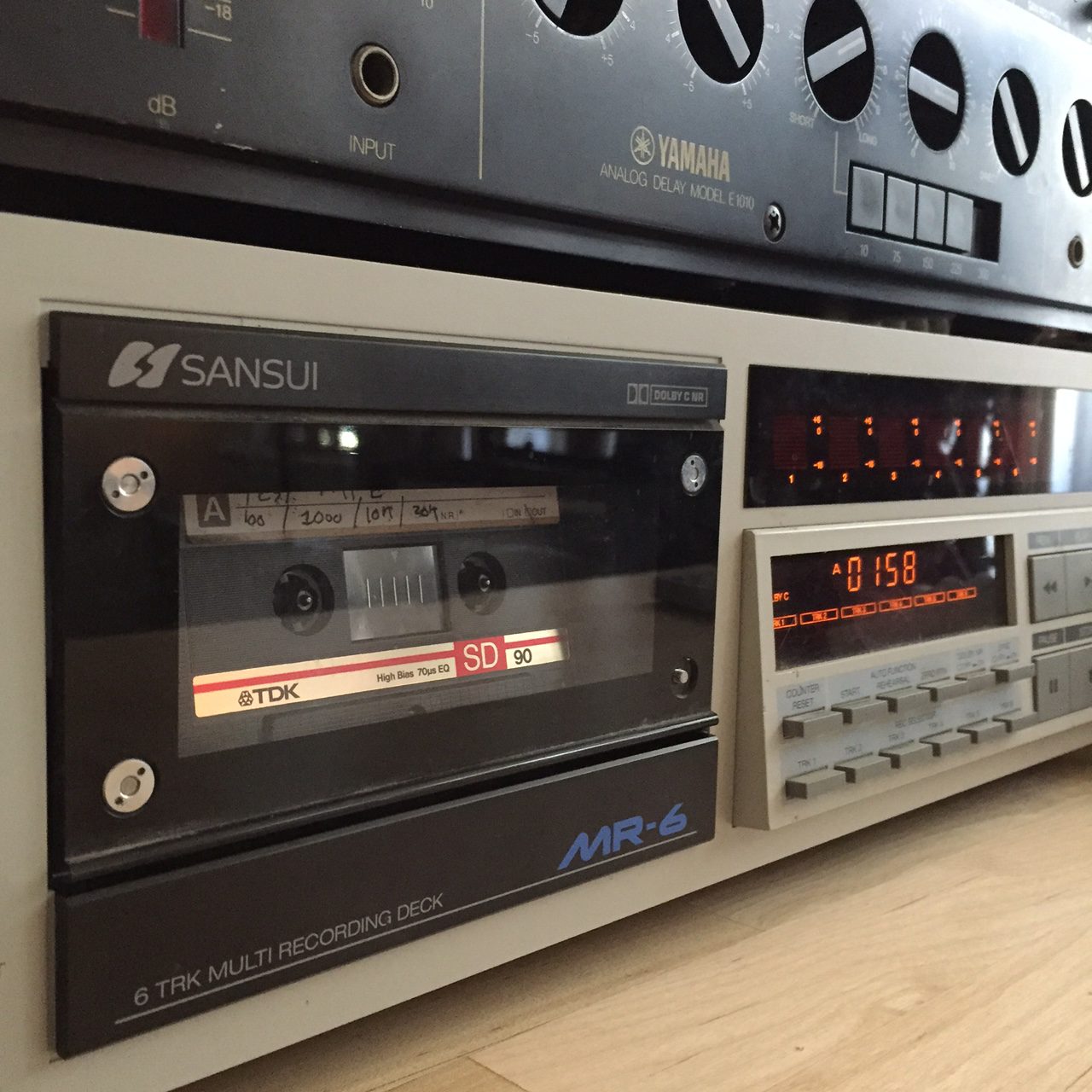 Our ongoing series of cassette multi-track experiments rolls on with the Sansui MR6.
Our ongoing series of cassette multi-track experiments rolls on with the Sansui MR6.
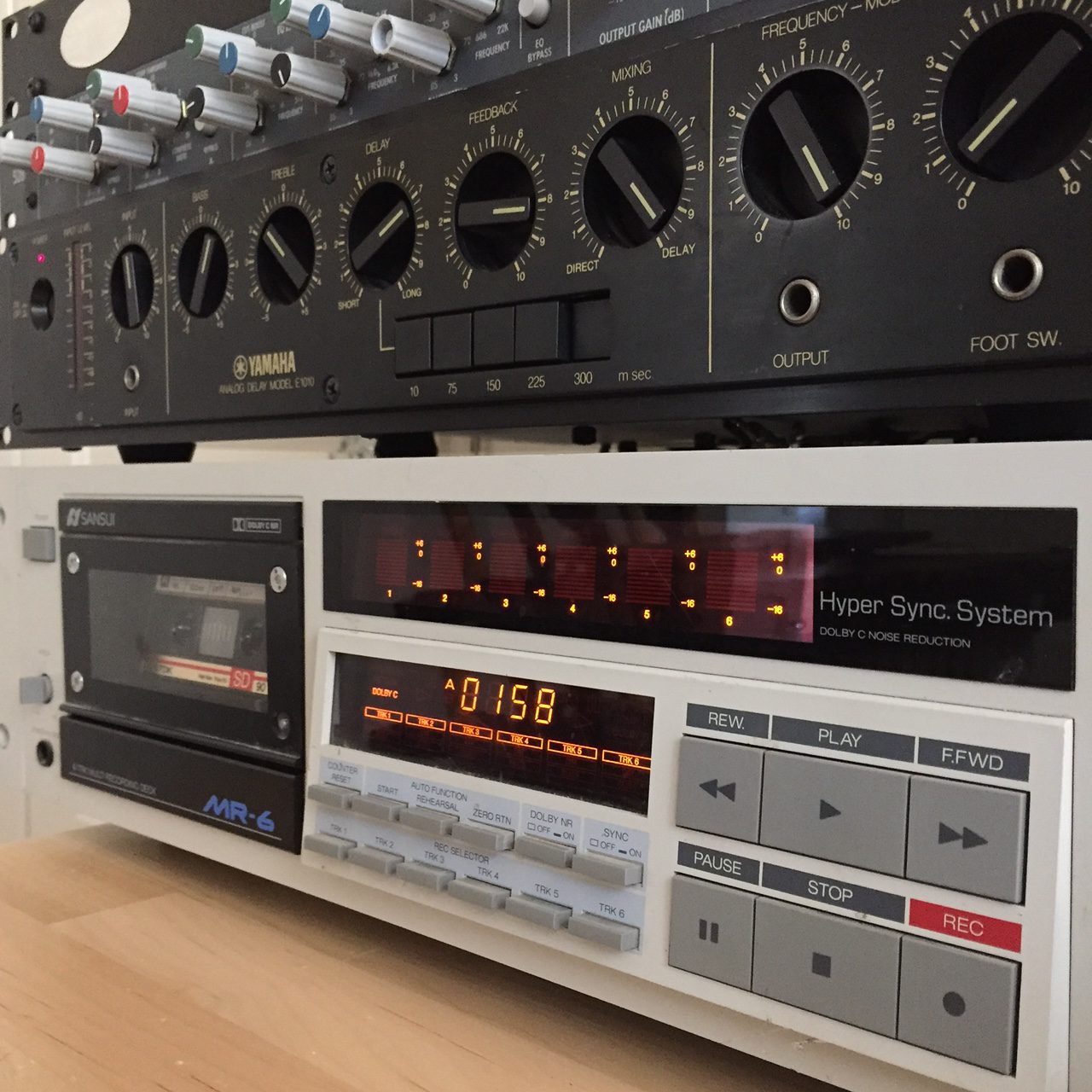 This ADAT-sized multitrack machine dates from 1990 or thereabouts. It records 6 tracks on a standard type 2 audio tape at double speed, with defeatable Dolby C and zero return. And that’s pretty much it. No gain trims, no autolocate, nothing. It really is strictly a tape machine and requires a mixer in order to use it in any sensible way. I picked it up for about $100 on ebay; a quick clean and demag and that’s it. Seems to work fine. High end response seems to trail off around 14k on a first-pass, which is A O K w/me. Here’s how it sounds, and thank u Jenny Holzer:
This ADAT-sized multitrack machine dates from 1990 or thereabouts. It records 6 tracks on a standard type 2 audio tape at double speed, with defeatable Dolby C and zero return. And that’s pretty much it. No gain trims, no autolocate, nothing. It really is strictly a tape machine and requires a mixer in order to use it in any sensible way. I picked it up for about $100 on ebay; a quick clean and demag and that’s it. Seems to work fine. High end response seems to trail off around 14k on a first-pass, which is A O K w/me. Here’s how it sounds, and thank u Jenny Holzer:
As with the earlier tracks in this series: the rules for tracking and bouncing are simple: no midi. no editing. Nothing u couldn”t do in the 80s. The only effects used for tracking are the Yamaha E1010 that you see there, a cheap boss reverb pedal, console EQ, and acoustic sources were tracked with some compression via that Symetrix 528E you see there. Marimba and shaker/tambo were mic’d with a Neumann KM184; vocals are an EV RE15 for no other reason that it is what I had on the desk at the moment.
Tracking was:
1: Korg volca beats kk/snare pulse sync’d to korg SQ1 driving that repeating 8-note figure on… 2: korg MS20, 3: one-note low pad on Minbrute, 4. Yamaha MR10 toms/CH SN dbl hand-played, 5. elec bass DI’d thru a cheap gtr preamp
(bounce to track 6)
- 8th note shaker/tambo played w foot, 2. Marimba (doubling and/or harmonizing MS20 part, 3. Basic polyphonic sampler of me singing an ‘A’ note ahhh, 4. analog choir synth sound
(bounce to track 5)
1, 2, 4: vocals (hi is doubled),
3: ch synth pad
My goal as with the previous productions was to mix this all on my lil Mackie Onyx 1220 el cheapo mixer into a single pair in Pro Tools, but I couldn’t find a way to route it while still using two FX returns (my patchbay on this lil desktop rig is very limited). So I played all six final tape tracks into P/T, and once in PT it was hard to resist applying a bit of EQ and compression to each stem. Also mix FX on vocals were via P/T (Echo Boy and Valhalla Verb). But that was it – no editing, no tuning, no fixin’. That weird noise at the head is probably some kinda bias abomination that resulted when I did the first bounce, but it’s really part of the charm, ain’t it. Whole mix is low passed at about 12K, which really ties it together IMO.
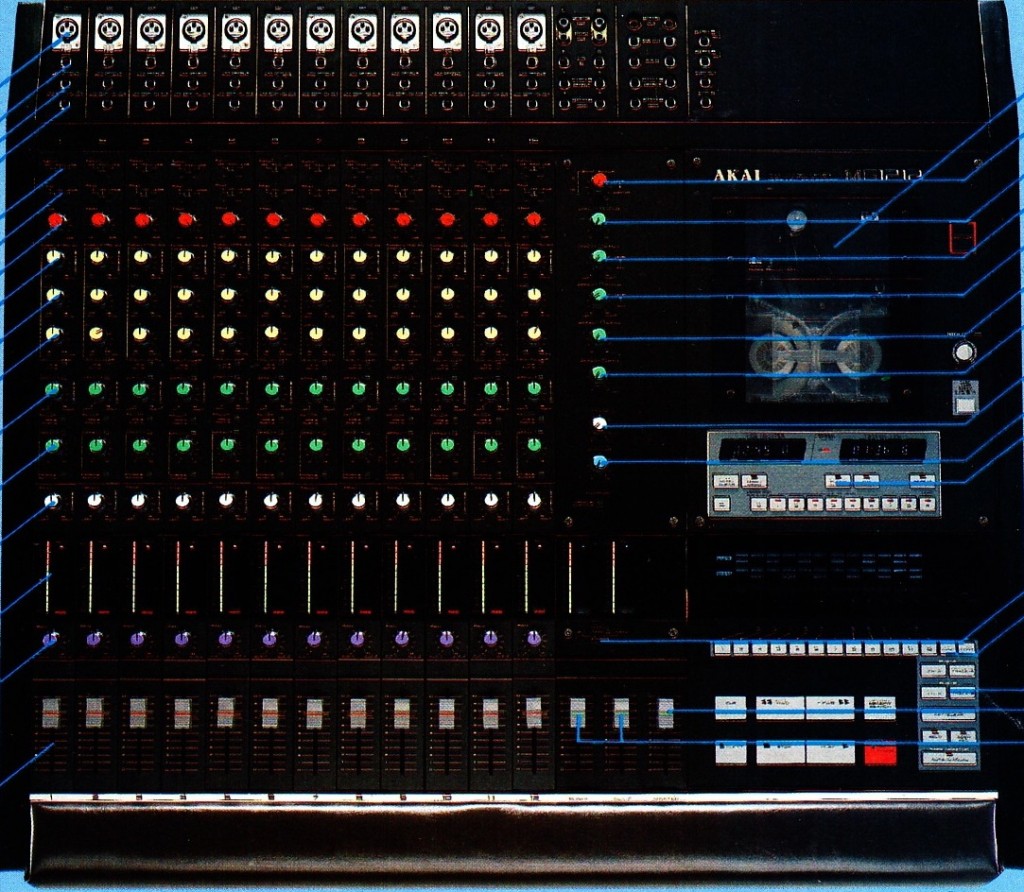 Today: just a few of the ‘Uber’ home-recording machines available to musicians in the 1980s. To this list I would also add the Audio Technica RMX64 and the AMR System 1, both which we have already covered recently at PS dot Com. If anyone is using these things to make music nowadays, drop us a line and tell us about it!
Today: just a few of the ‘Uber’ home-recording machines available to musicians in the 1980s. To this list I would also add the Audio Technica RMX64 and the AMR System 1, both which we have already covered recently at PS dot Com. If anyone is using these things to make music nowadays, drop us a line and tell us about it!
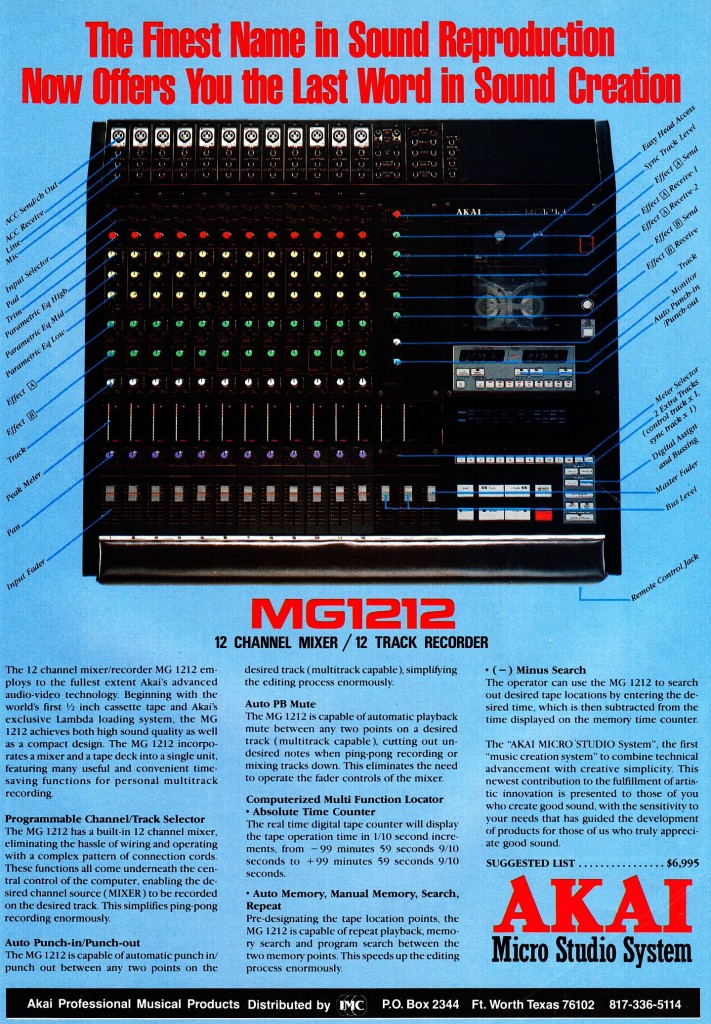 Above: the Akai MG1212 integrated 12-track recorder/mixer; all analog with automated punch in/out and VCA mute. I have a coupla memories of these things. When I was a kid East Coast Music mall had a used one that they were trying to sell for years. It sat at the front of the shop and it looked to me like a fkkn NASA computer. Years later, my college band The Cam Neely was invited to Boston to work with some Berklee students who needed to record some bands for… I have no idea frankly. And oh shit I have the ‘CD’ right here: the engineer’s name was Skip Hoefsmit. He recorded us on one of these machines, and I have to say, the recording sounds good considering i think we did two songs in about 6 hours and the only ‘production’ was that dude doubletracked our vocals. Hey Skip, still hustlin’? Drop us a line…
Above: the Akai MG1212 integrated 12-track recorder/mixer; all analog with automated punch in/out and VCA mute. I have a coupla memories of these things. When I was a kid East Coast Music mall had a used one that they were trying to sell for years. It sat at the front of the shop and it looked to me like a fkkn NASA computer. Years later, my college band The Cam Neely was invited to Boston to work with some Berklee students who needed to record some bands for… I have no idea frankly. And oh shit I have the ‘CD’ right here: the engineer’s name was Skip Hoefsmit. He recorded us on one of these machines, and I have to say, the recording sounds good considering i think we did two songs in about 6 hours and the only ‘production’ was that dude doubletracked our vocals. Hey Skip, still hustlin’? Drop us a line…
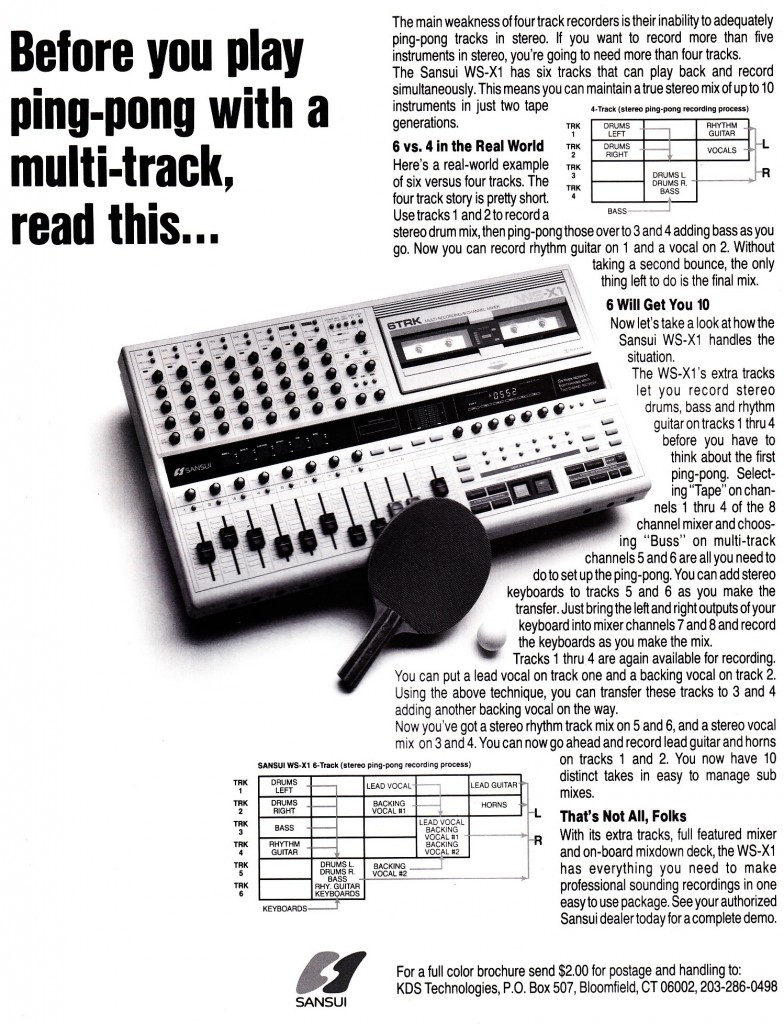 Above: the Sansui WS-X1 of 1990. OK so this thing is fkkn nuts. You get six discrete tracks on a cassette tape, built in digital reverb unit, and stereo mixdown deck, all in one unit. Some dude has a wordpress site solely devoted to this thing, and goddamn I want one of these!
Above: the Sansui WS-X1 of 1990. OK so this thing is fkkn nuts. You get six discrete tracks on a cassette tape, built in digital reverb unit, and stereo mixdown deck, all in one unit. Some dude has a wordpress site solely devoted to this thing, and goddamn I want one of these!
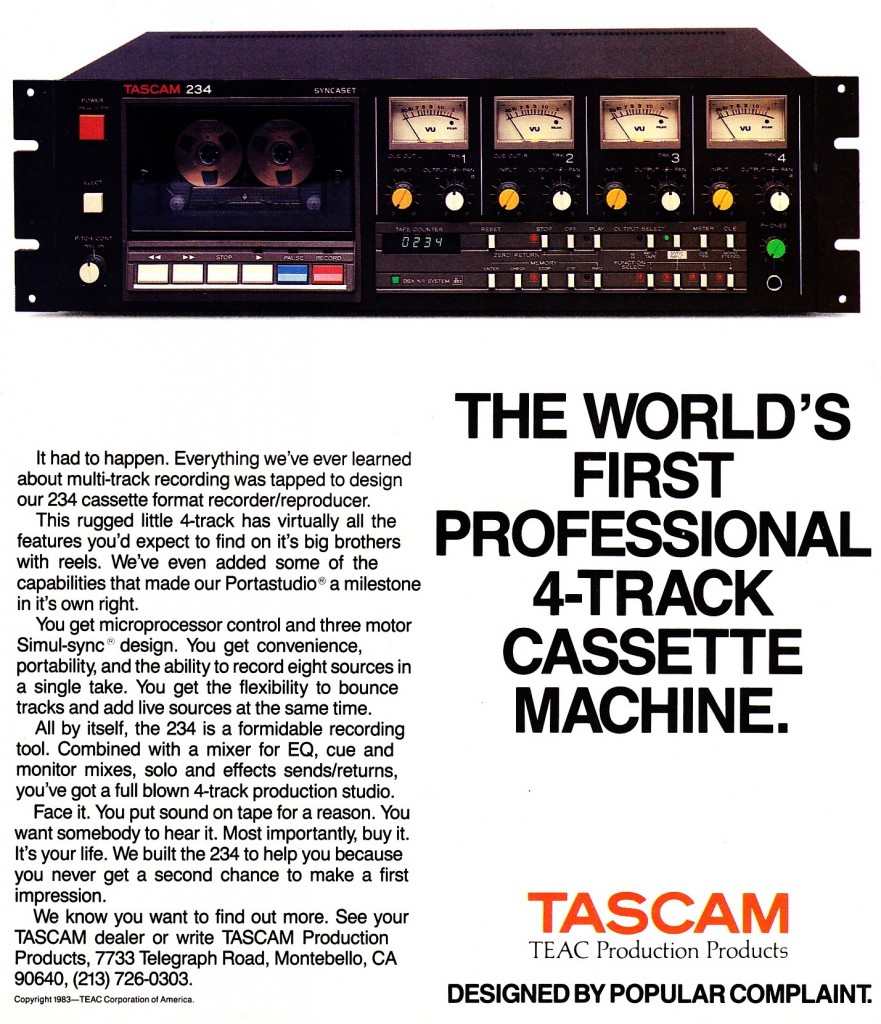 Ah Tascam 234. Someday you will be mine. I actually found one of these at a tag sale in Norwalk last year, $60 I think??? but it was totally dead. Despite all claims made by the seller. Luckily I keep a cassette tape and a pair of headphones in my car at all times (WOW that is so embarrassing) for these sorta occasions, so i was able to scope it and didn’t get snookered. Fkkn asshole DID manage to sell me some dead 10″ guitar speakers for $5 each though. Alright here’s an idea guys: when yr shit breaks, either fix it, have it fixed, or take it to the town recycling center. DON’T STORE IT IN THE BASEMENT AND THEN STICK SOMEONE ELSE WITH IT 5 YRS LATER. For fukks sake, why do people keep broken crap around? We’re inundated with enough WORKING crap. Jesus.
Ah Tascam 234. Someday you will be mine. I actually found one of these at a tag sale in Norwalk last year, $60 I think??? but it was totally dead. Despite all claims made by the seller. Luckily I keep a cassette tape and a pair of headphones in my car at all times (WOW that is so embarrassing) for these sorta occasions, so i was able to scope it and didn’t get snookered. Fkkn asshole DID manage to sell me some dead 10″ guitar speakers for $5 each though. Alright here’s an idea guys: when yr shit breaks, either fix it, have it fixed, or take it to the town recycling center. DON’T STORE IT IN THE BASEMENT AND THEN STICK SOMEONE ELSE WITH IT 5 YRS LATER. For fukks sake, why do people keep broken crap around? We’re inundated with enough WORKING crap. Jesus.
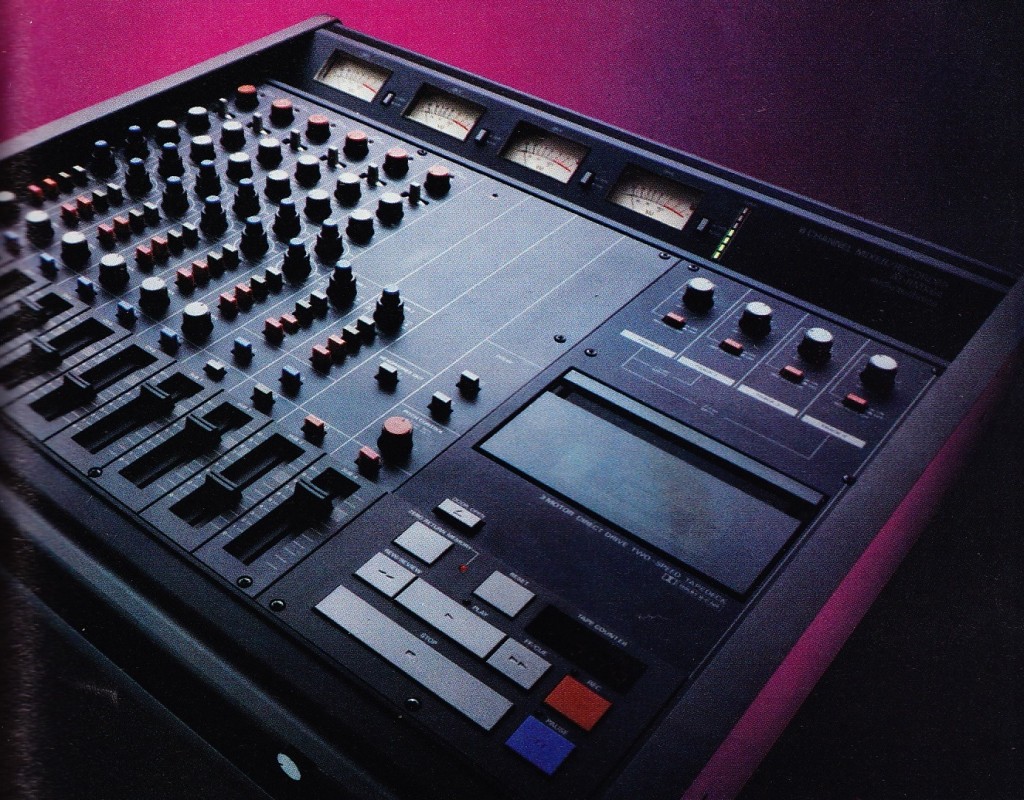 We recently featured the 1986 AMR (aka Peavey) Series 1 four track; also in the running for ‘KING OF THE CASSETTE 4 TRACKS’ was the Audio-Technica RMX64, introduced in 1985. Six input channels, phantom power, 4 sub outs, 2 effect sends, 2-band sweepable EQ (switchable from shelf to peak!)… man I would love to find one of these. Anyone?
We recently featured the 1986 AMR (aka Peavey) Series 1 four track; also in the running for ‘KING OF THE CASSETTE 4 TRACKS’ was the Audio-Technica RMX64, introduced in 1985. Six input channels, phantom power, 4 sub outs, 2 effect sends, 2-band sweepable EQ (switchable from shelf to peak!)… man I would love to find one of these. Anyone?
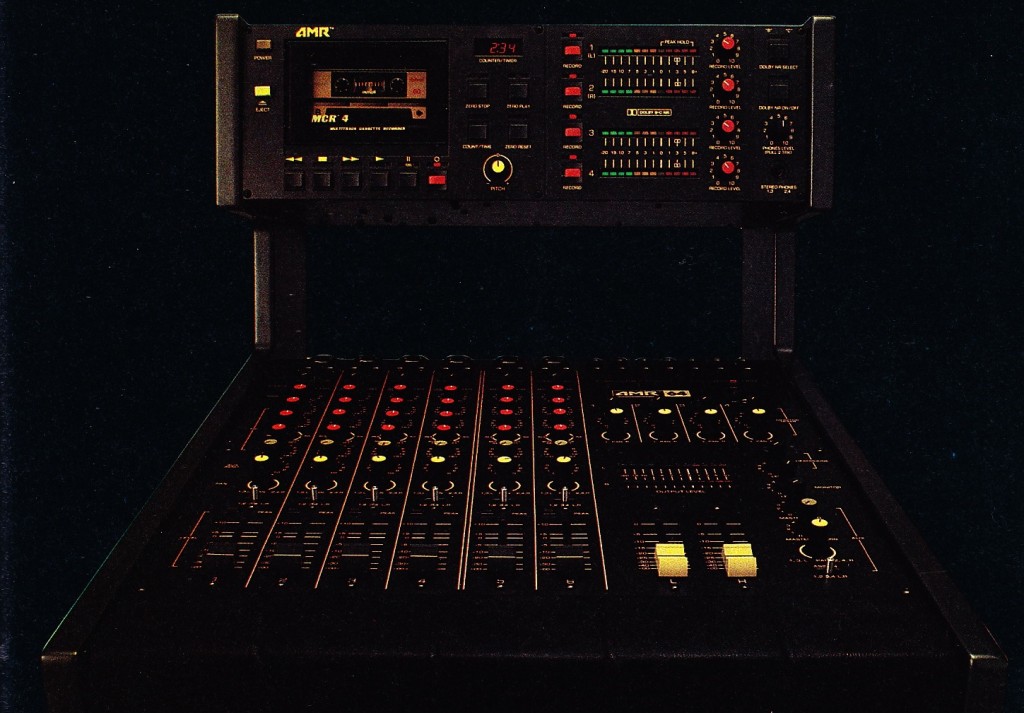 Goddamn! Would you look at that thing! Peavey built and sold a small number of these US-made uber-4-tracks in the late 80s. They were referred to alternately as the MCR-4 or the System 1. I have personally never seen one, but I love that tape-machine-overbridge layout… makes me wanna buy a Tascam 234 and a little rack-mount 80s mixer and cart it up like that… I know I poke fun at Peavey quite a bit, but my hat is off to them for this thing. To build something like this in the US in the 1980s must have taken incredible effort. To learn more, check out this thread at Tape Op.
Goddamn! Would you look at that thing! Peavey built and sold a small number of these US-made uber-4-tracks in the late 80s. They were referred to alternately as the MCR-4 or the System 1. I have personally never seen one, but I love that tape-machine-overbridge layout… makes me wanna buy a Tascam 234 and a little rack-mount 80s mixer and cart it up like that… I know I poke fun at Peavey quite a bit, but my hat is off to them for this thing. To build something like this in the US in the 1980s must have taken incredible effort. To learn more, check out this thread at Tape Op.
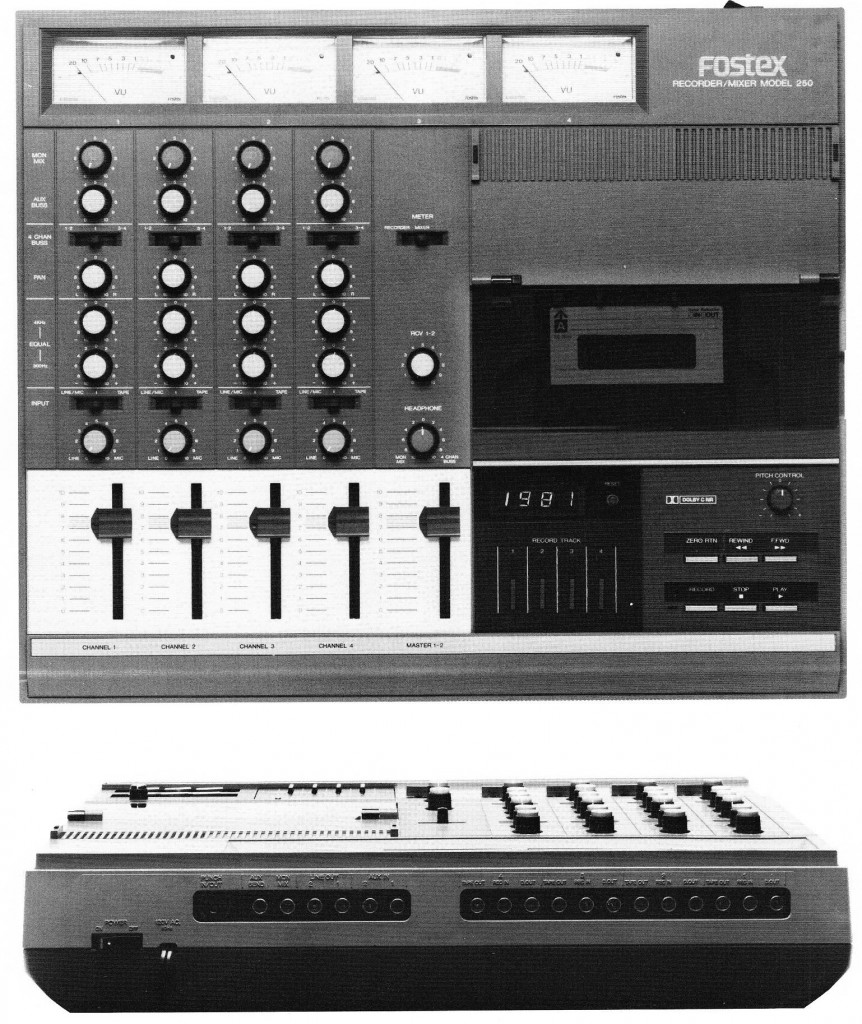 Download the complete 12pp Fostex “Creative Sound Systems” 1981 (???) catalog:
Download the complete 12pp Fostex “Creative Sound Systems” 1981 (???) catalog:
DOWNLOAD: Fostex_1981_Catalog
Models covered in great detail include: Fostex A-8, A-4, A-2 1/4″ tape machines; Fostex 250 cassette four-track; and the Fostex 350 8x4x2 mixer.
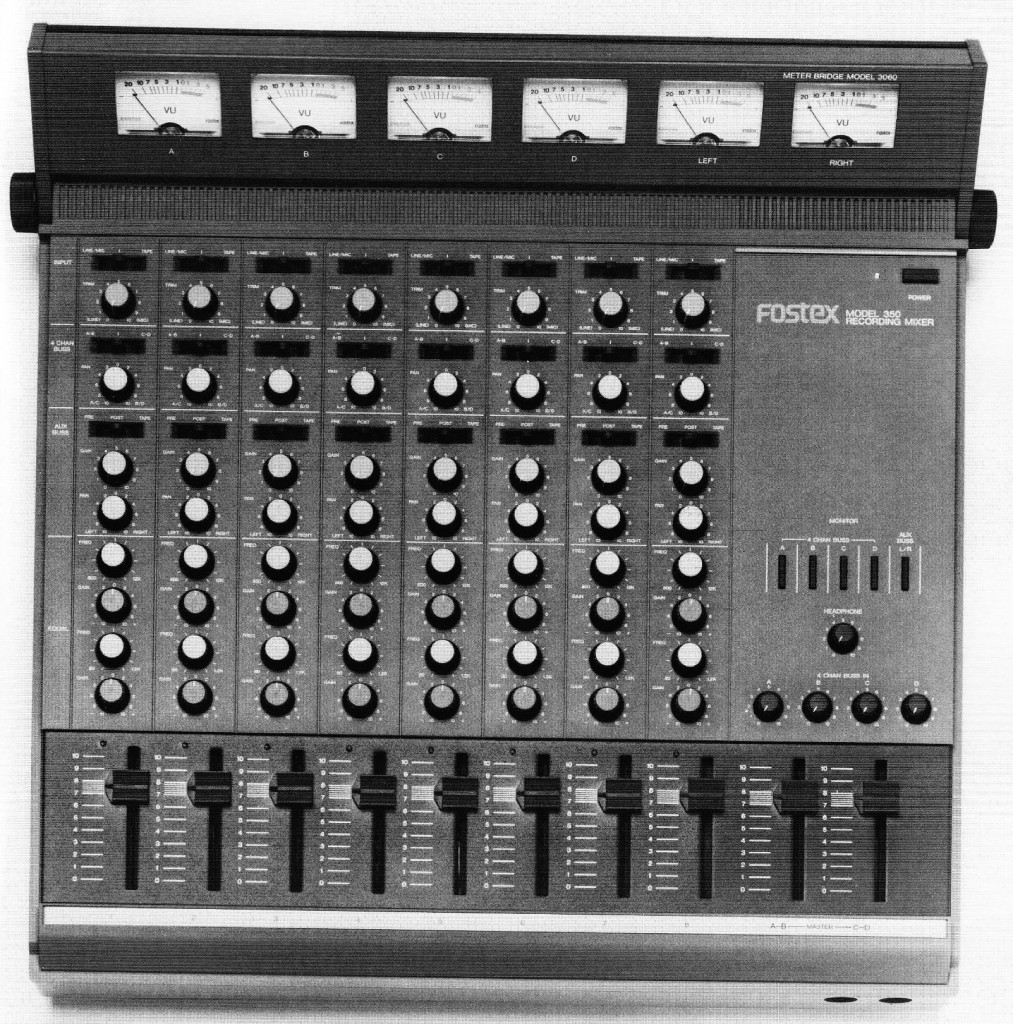 Interesting feature on the 350 – and something that’s not at all obvious from the top surface – it has 2 stereo RIAA phono preamps which are patchable on the rear of the unit, presumably to whichever inputs or external gear you like.
Interesting feature on the 350 – and something that’s not at all obvious from the top surface – it has 2 stereo RIAA phono preamps which are patchable on the rear of the unit, presumably to whichever inputs or external gear you like.
I’ve uploaded a ton of information on these machines before (see here, here, and here), so dig back if you want more commentary… otherwise i’ll let the catalog speak for itself…
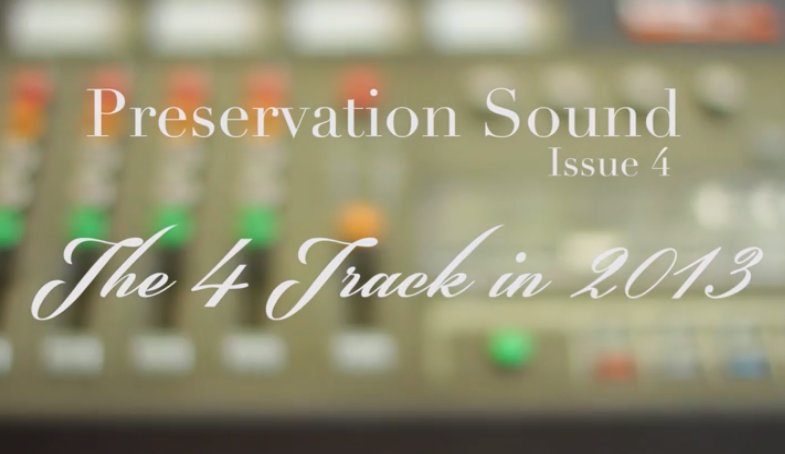 I am v v pleased to announce that PSV #004 is now online. “The 4-track in 2013” looks at the possibilities that an old-school cassette 4-track machine offers when used in conjunction with a digital audio workstation. We do this through the work of John Panos, aka KINGS. Panos’ music is some of the best new stuff I’ve heard in a while, and he has some really insightful things to say about tape noise and distortion and how these things work as both an arrangement element and a sonic frame, situating parts of the track within an historical context informed by the legacy of cassette-distributed popular music. Check it.
I am v v pleased to announce that PSV #004 is now online. “The 4-track in 2013” looks at the possibilities that an old-school cassette 4-track machine offers when used in conjunction with a digital audio workstation. We do this through the work of John Panos, aka KINGS. Panos’ music is some of the best new stuff I’ve heard in a while, and he has some really insightful things to say about tape noise and distortion and how these things work as both an arrangement element and a sonic frame, situating parts of the track within an historical context informed by the legacy of cassette-distributed popular music. Check it.
For more about KINGS, check out:
KINGS website / Blog / Music / Twitter
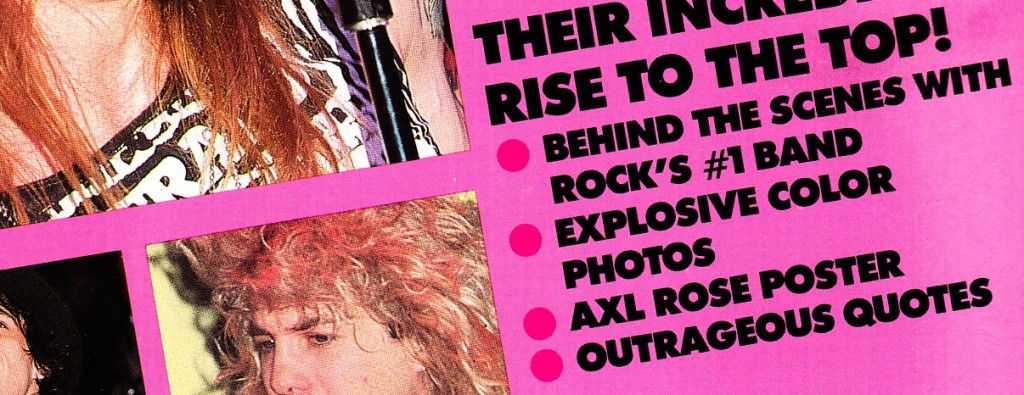 “Home Studios are one of the fastest-growing segments of the music equipment industry. The availability of (fill in the blank) is killing the low-end professional studio scene. After all, why should musicians pay $1,000 to record on someone else’s four-or-eight track system when they can purchase their own system for the same price?”
“Home Studios are one of the fastest-growing segments of the music equipment industry. The availability of (fill in the blank) is killing the low-end professional studio scene. After all, why should musicians pay $1,000 to record on someone else’s four-or-eight track system when they can purchase their own system for the same price?”
Download a 2-pp article from CIRCUS magazine, 1989, on the subject of Home Studio Recorders. Author is one R. J. Grula. (via The More Things Change ETC dept.)
DOWNLOAD: Circus_4trk_1989_0001
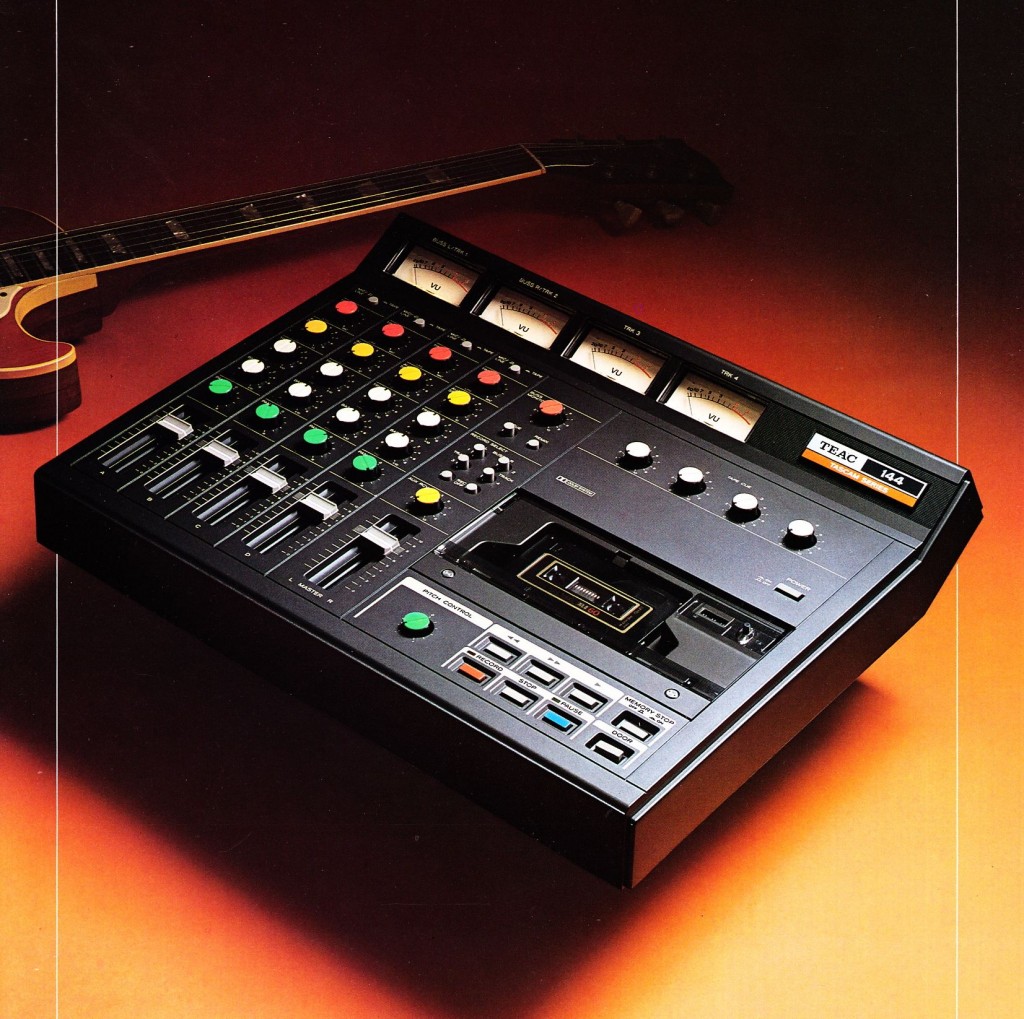 Download the original 6pp brochure/catalog for the Tascam 144, the first ‘4-track’ ‘porta-studio’:
Download the original 6pp brochure/catalog for the Tascam 144, the first ‘4-track’ ‘porta-studio’:
DOWNLOAD: Tascam_144_Catalog
I’m a little embarrassed to admit/realize that this is the third post we’ve done on the 144. First was this article regarding 4-track aesthetics, followed by this post containing the 144 product-launch advertising. I just recently came across this original promo item, and it seems that no one else had bothered to put it online, so what the hell. I’ve already said enough about this crucial, paradigm-shifting object, so I won’t repeat myself here… check the old posts if you care.
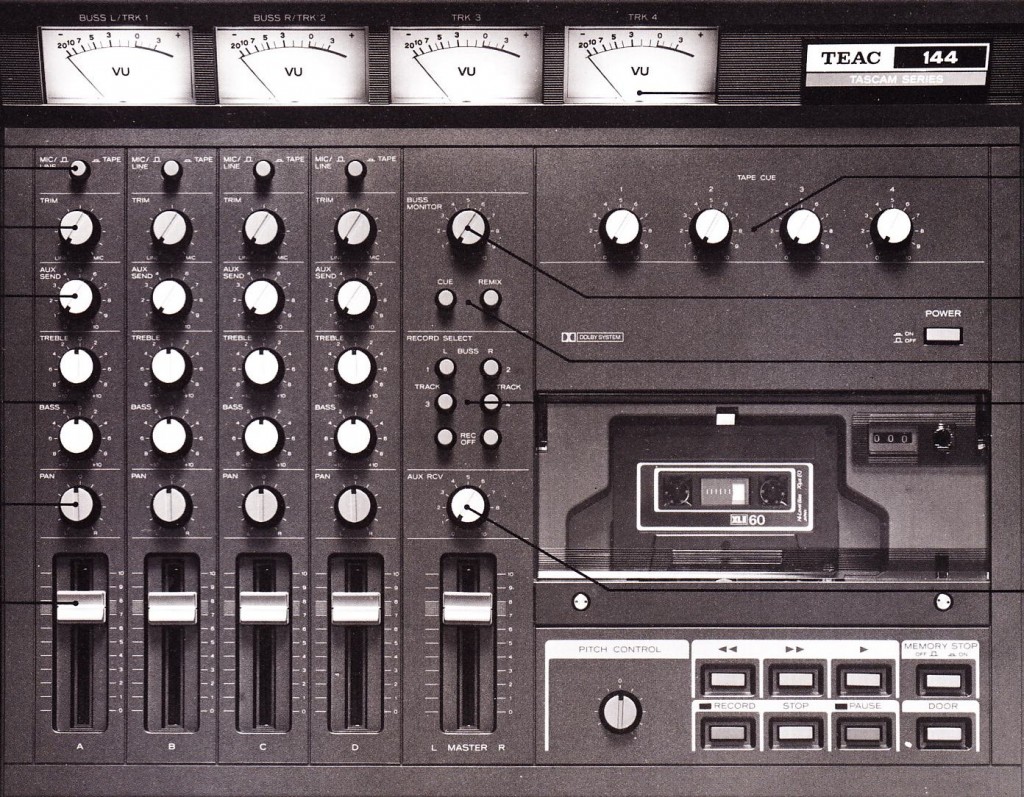
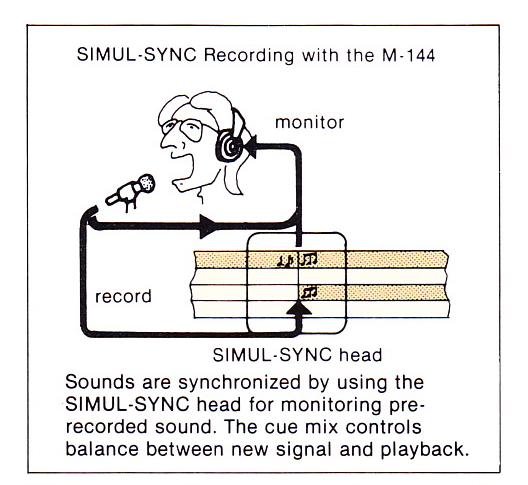 Shit, how did they know what kinda glasses I wear? Oh wait I’m stuck in 1979. Riiiiiiiiiight.
Shit, how did they know what kinda glasses I wear? Oh wait I’m stuck in 1979. Riiiiiiiiiight.
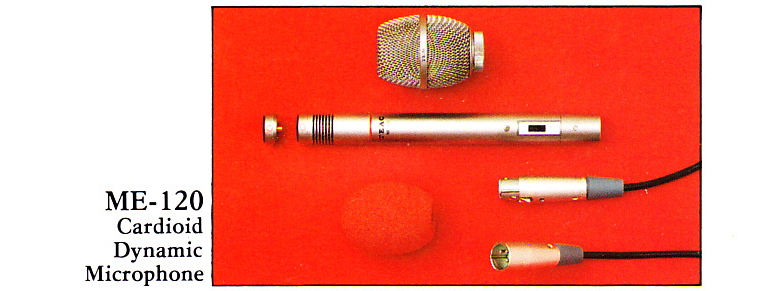 The catalog also contains info on a number of ‘accessories’ that Tascam offered in conjunction with this machine; above, their top-end mic the “ME-120” which came with interchangeable omni and cardiod capsules. Pretty fancy Tascam. I have somehow ended up with just the box and omni capsule for one of these things. WTF?
The catalog also contains info on a number of ‘accessories’ that Tascam offered in conjunction with this machine; above, their top-end mic the “ME-120” which came with interchangeable omni and cardiod capsules. Pretty fancy Tascam. I have somehow ended up with just the box and omni capsule for one of these things. WTF?
Beyond Four Tracks
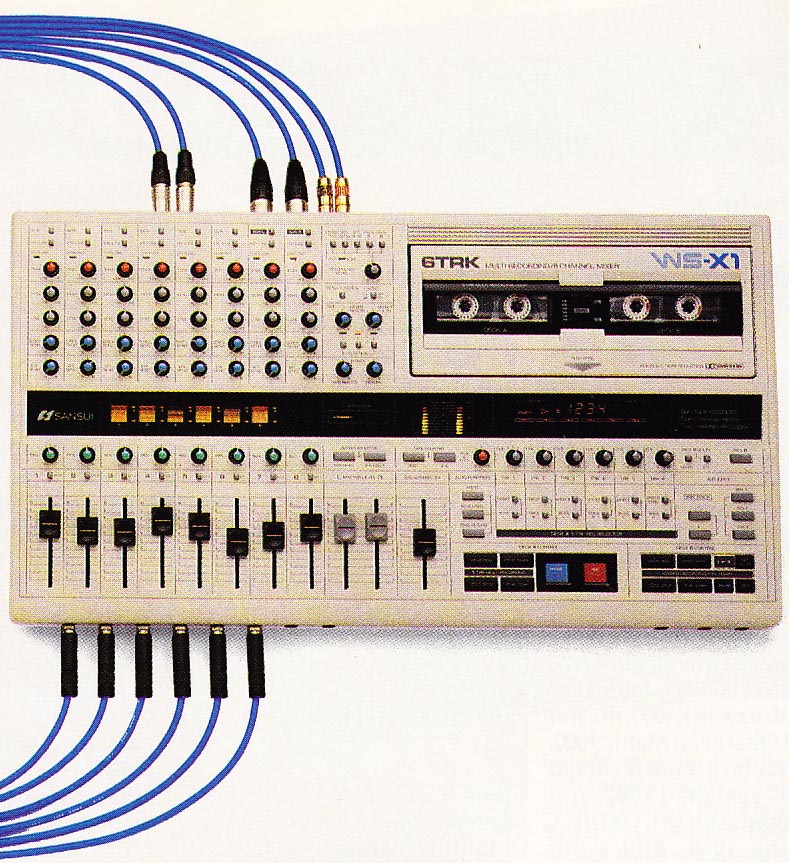 Sansui six-track cassette format c. 1989
Sansui six-track cassette format c. 1989
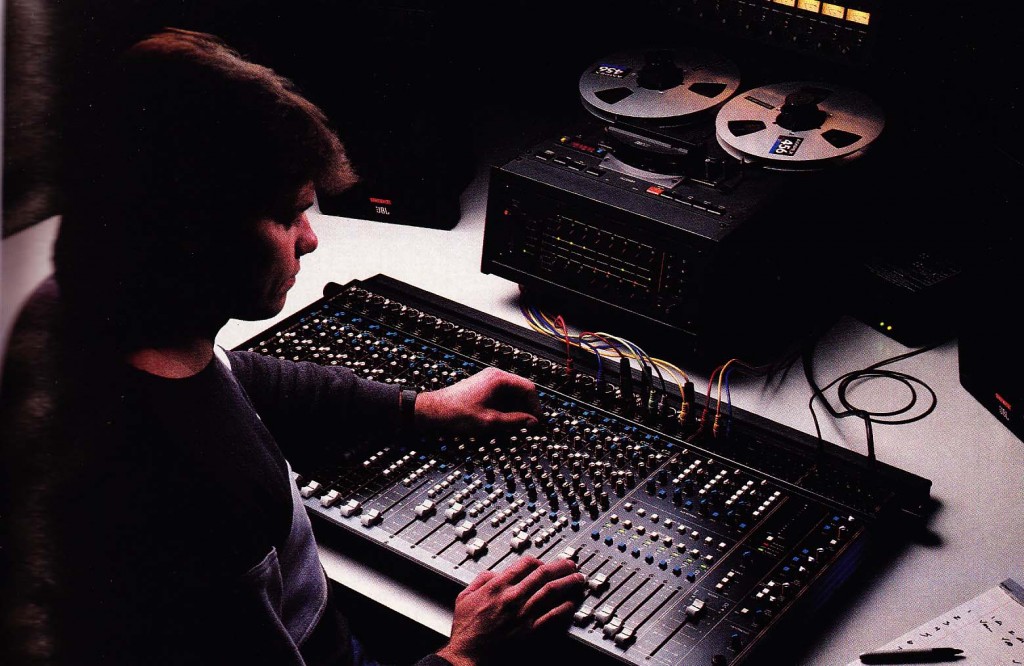 Otari Compact 8-track 1/2″ format c. 1989. Also, SECK mixer.
Otari Compact 8-track 1/2″ format c. 1989. Also, SECK mixer.
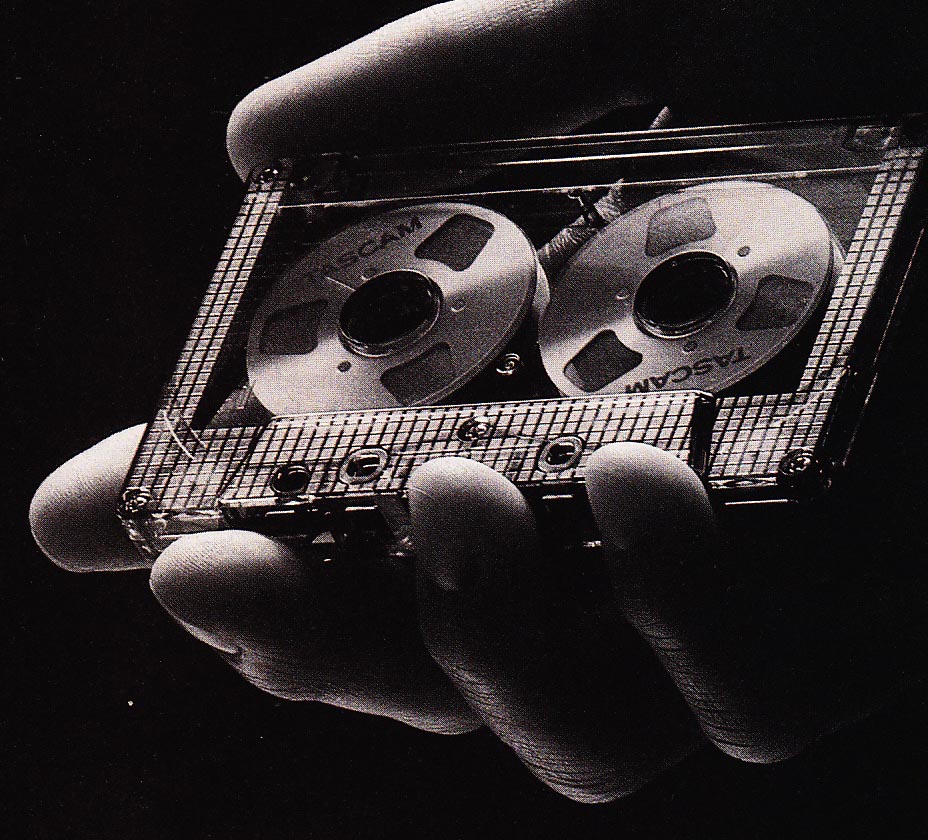 …and you better bet TASCAM made one too.
…and you better bet TASCAM made one too.
Above: some short-lived “more-than-four” home-recording formats that were available between the 4-track cassette and ADAT eras. It’s kind hard to imagine how significant an issue ‘track count’ (IE., the number of available tracks of a particular multi-track recording machine) was just a short while ago. It’s not unusual at all these days for me to make a production for an artist that has 80 or even 100 tracks. And I am not talking about some crazy orchestral or prog-rock epic; I am talking about just a well-produced indie pop song. Modern music means layering. Lots of it. When I, and many other folks started doing this, we dreamed of someday having more than 8 tracks to work with. Well, as it turns out, ‘more’ didn’t mean 16, 24, or even 48: it meant infinite. “Be careful what you wish for…”
What will be the next technological barrier to fall in the world of audio production?
I wouldn’t mind seeing all those goddamn wires go away, for one…
Any other ideas?
